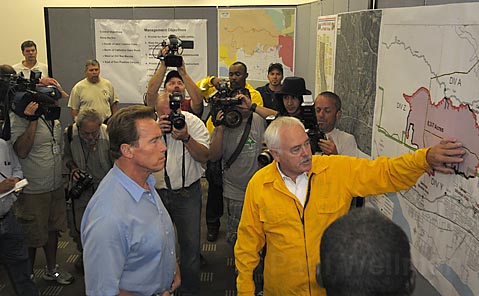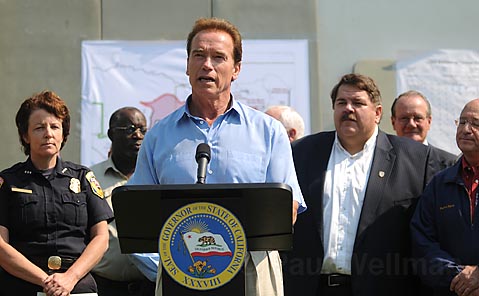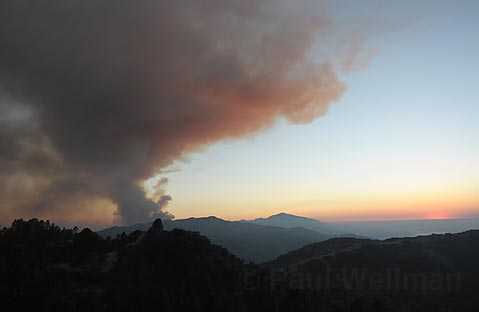Fire Chief Thought 100 Homes Would Burn Friday Night
Gov. Schwarzenegger on Scene: Gap Fire Still Number One Priority

Surrounded by a star studded cast of every notable elected official and high ranking fire fighter within a 100-mile radius, Governor Arnold Schwarzenegger affirmed that the Gap Fire now plaguing the South Coast for the fifth straight day was still the state’s Number One fire fighting priority. Schwarzenegger was on hand Saturday morning to hear a briefing from the incident command stationed at the Earl Warren show grounds on how the campaign against the Gap Fire was proceeding, and what additional resources were required to fight it. Dressed in ornate cowboy boots, a blue button-down cotton shirt, and khaki pants, the governor said more resources and firefighters could soon be dispatched to Santa Barbara because 81 percent of the hundreds of other wildfires blazing throughout the state are technically contained. As those fires increasingly come under control, the governor pledged, more firefighting equipment and personnel can and will be sent to bring the Gap Fire to heel.

Schwarzenegger also provided a quick run-down of the Gap Fire’s status as of early Saturday morning. At that point, he said, the fire had grown to 8,357 acres-up from 6,000 yesterday at 2:00 p.m. He noted that the occupants of 3,000 structures have been warned they might need to evacuate soon, while the residents of another 1,855 homes had already been ordered to pack up and get out. Fighting the fire, he said, were 1,072 firefighters and 141 fire engines. (Yesterday morning, the figure was 800 firefighters.) Putting this in the context of the statewide epidemic of forest fires that began two weeks ago, Schwarzenegger noted that more than half a million acres statewide have been consumed by fire, and that 67 structures have burned. Fighting these infernos are 20,000 firefighters equipped with nearly 1,100 fire engines.
Sporting a head of hair with an otherworldly orange tint that calls to mind the eerie golden light cast throughout the Gap Fire, the governor praised California firefighters as among the most experienced and dedicated in the nation, pointing out that many of them are exhausted from working 72 hours without any sleep. In the short-term, he said he’s already gotten 400 national Guardsmen in training to help join the fire fighting effort, and expects to ask for an additional 200 beyond that.
The governor noted that wildfires are no longer respecting California’s traditional fire season starting in June and ending in October. “Now there is no more fire season,” he said. “We have fires all year round. What this means, we need more resources.” To this end, he said he inserted $70 million in emergency response funding that would be paid for by charging homeowners an additional dollar per month per property. “There will be some who will start debating is this is a fee or is this a tax increase,” he predicted. “I don’t care what they call it. We just want additional revenues.”
That distinction is germane in light of the bitterly partisan divide that defines the state legislature on all matters fiscal. Typically, the Republican leadership-devoutly anti-tax-has been quick to define anything that increases state revenues as a tax increase; and all tax increases, by law, require a two-thirds super majority for approval. Given that the Democrats cannot deliver that volume of votes even though they command clear majorities in both houses, they typically define such revenue enhancers as fees. As opposed to tax increases, fees can be approved by a simple majority, which the Democrats clearly have.
Schwarzenegger noted that 41 different states have supplied firefighters and equipment in California’s hour of need. He praised such cooperative efforts-as well as those between the state, federal, and local firefighting agencies now battling the Gap Fire-observing that different agencies often have different agendas, which don’t always mesh. “It is not sometimes easy,” he said. He contrasted the harmonious inter-agency cooperation now taking place with the Gap Fire to what happened with Hurricane Katrina in Louisiana. “It’s unlike what happened with Katrina where nothing happened and everything went wrong,” he said. “Here, everything goes right.”
Friday night, things went exceedingly right for the firefighters on the front lines. They were lucky, too: Although sundowner winds were gusting at times as fast as 50 miles an hour, they still weren’t as bad as the night before, when the fire ran down the mountain and licked the corner of a home off North Patterson in Goleta. Keeping the downward path of the fire somewhat in check were the fire breaks-some five bulldozer blade widths across. Also taking its toll on the flames was fire retardant throughout the day. For the fifth straight night, firefighters-and the community at large-dodged a major bullet: Not one home has gone up in smoke yet. There’s even some doubt now whether the single mobile home that was reported destroyed actually was. Unconfirmed anecdotal accounts suggest it too may have been saved.
Good news, however, is a highly relative term when fighting a fire that’s grown from 5,400 acres to 8,300 in the course of a day. “Be under no illusion that we’ll be out of the woods soon,” cautioned incident commander John Smith. “This is one tough, tough fire.” County Fire Chief John Scherrei recalled that at least twice on Friday night he figured that 100 homes would be lost to the fire. He reported that the flames came within one quarter-mile of structures near Painted Cave and the Trout Club, mountain communities located just west of San Marcos Pass Road. To save those homes, Scherrei said he had to conscript all available firefighters at his command–even those who are assigned to fire stations throughout the county in case other fires break out elsewhere. Last night, Scherrei said, he took the unprecedented step of temporarily closing down no less than seven station houses to help protect the Painted Cave area.
In some ways, the fire and the firefighters find themselves engaged in a high stakes cat-and-mouse game in which the fire tries to race up the mountain by day-seeking out the more plentiful oxygen found at higher ground-and then back down the hills again at night, pushed by sundowner winds. (A much more muscle-bound variety of these sundowners was responsible for moving the fire of the Painted Cave Fire in 1990 down the hill and across the freeway in no less than 90 minutes.) The firefighters are trying to hold the line at Camino Cielo to the north; if the flames should jump that ridge, it’s Katy-bar-the-door. The vegetation there is thick, dense, and highly inaccessible. “It got right up to the asphalt,” Scherrei said of the fire’s proximity to Camino Cielo on Friday night. “But it never got over.”

To the west, they’re trying to keep the fire penned in just west of the Old San Marcos Pass Road-and definitely Highway 154–and to this end, they’ve been largely successful. A couple of spot fires got past yesterday, but they were extinguished soon afterwards. Two nights ago, the fire came within licking distance of a home off North Patterson and the three county firefighters working the engine were forced by the heat to seek shelter inside the garage for about 25 minutes. But there’s a belt of orchards that runs parallel to Cathedral Oaks separating much of suburban Goleta from the raging hillsides. The fire’s main growth to date has been in a westward direction, and incident command maps show a pointy spear of uncontrolled flame-on the southwestern flank of the fire-poking down into Winchester Canyon.
The campaign against the Gap Fire has been hampered by lack of resources from the start; with the whole state aflame, the competition for engines, planes, crews, and helicopters has been intense. But with Schwarzenegger’s wind at the county’s back, Scherrei said the county could use four more large double-tower helicopters to drop water scooped up from Lake Cachuma on the blaze. That’s in addition to the six helicopters deployed Thursday. And that’s in addition to the 15 planes deployed in the effort, as well. Fire officials caution that the availability of aircraft is determined on a daily basis, depending upon other statewide priorities. Incident Commander Smith said he’s already put in an order for 20 to 40 more experienced hand crews-hot shots, three of the large helicopters, and as many as 10 new “Strike Team” engines capable of making sharp turns in rugged terrain with precious little clearance. And the DC-10-the biggest, most dramatic and re-assuring plane in the firefighters’ aviation arsenal-will be back for at least another day of dropping flame retardant. On Friday, the DC-10 made five runs.
So far, only two firefighters have reported injuries. In both instances they suffered from smoke inhalation and smoke blindness that required a quick visit to Cottage Hospital so their eyes could be flushed of smoke. At this point, the fire is officially 24 percent contained. “That statistic is a little passe,” cautioned Chief Scherrei. “The wind could change and we’d be back at zero in a second.” In the meantime, Sheriff Bill Brown announced that everyone living north of Cathedral Oaks between Highway 154 and Old San Marcos Pass Road should keep their bags packed and be ready to move. When new evacuation orders are issued, they will likely be the first to go.
If last night’s winds were more favorable than the night before, Scherrei said he’s expecting tonight’s to be even lighter still. To keep that in perspective, that means better than gusts ranging from 40 to 50 miles an hour. He also said that there are forecasts rumoring the arrival of monsoon-like humidity. If true, that too would help.



